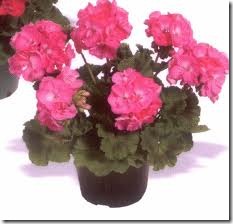Geraniums are one of the most reliable plants for the home gardener, according to the University of Rhode Island Landscape Horticulture Program. Many varieties of geraniums exist, and all produce flowers and seeds through their life cycle. Depending on the planting area, geraniums may be annuals or perennials. This means that a plant can live through one growing season (annual) or many growing seasons (perennial), depending on the weather conditions of the area.
Germination
-
Germination of seeds starts the life cycle of the geranium. Seeds are sown approximately three months before the last frost date for the area. The North Carolina Cooperative Extension Service recommends starting seeds in a commercial starting medium in a flat container, spacing seeds 1/4 inch apart in rows 1 to 2 inches apart. When starting geranium seeds, the gardener must first scarify the hard coating by scratching to break the seed coat. The ideal seed starting temperature for geraniums is 72 degrees Fahrenheit. The medium should be kept moist. Germination occurs in 7 to 14 days. Seedlings may be transplanted into larger containers and then moved outdoors when the danger of frost is over.
Growth
-
The growth stage of a geranium occurs from seedling to mature plant. Most geraniums take 95 days to 110 days to mature from germination, according to the North Carolina Cooperative Extension Service. Described as a "shrubby" plant, geraniums grow up to 3 feet tall. For optimum growth, geraniums prefer moist, organic-rich soil that drains well. In cool climates, gardeners benefit from planting geraniums in sunny locations, but hot-climate gardeners should plant geraniums in partly shady areas. Moist soil promotes fast growth and maximum size.
Seed Production
-
Once mature, the geranium produces 1 to 1 1/2 inch wide flowers featuring five petals. The flower colors range from light pink to dark purple. When planted after the danger of frost, most geraniums begin producing flowers in midsummer. Pollen is transferred from the flower anther to the stigma by wind, water or animal. The geranium produces seeds that have a hard seed coat in order to inhibit germination until the next spring, when weather conditions are favorable for growth. This starts the cycle over again.
Propagation by Cutting
-
Gardeners use cuttings to propagate geraniums from mature plants, rather than starting with seeds. Cuttings are made from the tip of stems and then placed in perlite or sharp sand. When placed in a north or east window with temperatures between 72 and 75 degrees Fahrenheit, the cuttings will root in three to four weeks. The University of Rhode Island Landscape Horticulture Program recommends watering cuttings only sparingly during the rooting period. Once rooted, the cuttings may be transplanted to pots for establishing before being moved to outdoor flower beds. The life cycle of the cutting-propagated geranium then continues as it would for seed-propagated geraniums.


Deprecated: strpos(): Passing null to parameter #1 ($haystack) of type string is deprecated in /home/agriviek8Qv/agriviet.net/public_html/wp-includes/comment-template.php on line 2522